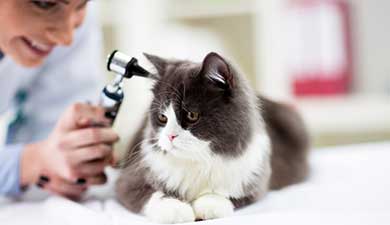Cancer in cats: your essential guide to the signs, treatment and care
Quick Links
What is cancer?
Cancer is a disease caused by a collection of abnormal cells in the body growing and dividing uncontrollably, which form growths called tumours. Not all tumours are cancerous – those that only grow where they originated are described as ‘benign’, and are much easier to treat.
Cancerous tumours are often described as ‘malignant’ – they disrupt the normal functioning of the body and its organs, and can spread through the body. Cancer cells break away from the primary tumour and travel through the bloodstream or lymphatic system, creating new tumours.
Cats develop tumours less frequently than dogs, but when they do, they’re unfortunately three to four times more likely to be malignant.
Signs of cancer in cats
Due to the many different types of cancer in cats, there’s no definitive checklist of symptoms. If you find a lump or growth on your pet, always get it checked by your vet as soon as possible.
You should also consult your vet about any sores that don’t heal; chronic weight loss; changes in appetite; a persistent cough; lameness or stiffness; very smelly breath; persistent lethargy; difficulty with eating, swallowing, breathing or going to the toilet; regular vomiting or diarrhoea; and bleeding from any bodily opening. These can all be symptoms of cancer in cats, or of other underlying health conditions, so it’s always best to get them checked out.
Common types of cancer in cats
Lymphoma
Mammary cancer
Skin cancer
Fibrosarcoma
Mouth cancer
Getting a cancer diagnosis
To confirm whether your cat has cancer, a clinical examination by your vet may be followed by blood tests, and an X-ray or ultrasound to identify the location of any tumour, and the extent of its spread. Your cat may also need a biopsy (the surgical removal of a tiny piece of affected tissue, to be examined further).
CT or MRI scans are becoming more widely available for our pets, particularly for suspected brain tumours.
Cancer treatments for cats
As with humans, the most common treatments for cancer in cats are surgery, chemotherapy or radiation therapy. The treatment offered will depend on the type and location of the cancer, whether it has spread, and what’s best for your cat’s quality of life.
Sometimes surgery can be an effective treatment for cancer in cats, especially skin cancer. For mammary cancer or fibrosarcoma, surgery may be followed by chemotherapy to stop cancerous cells reoccurring.
Chemotherapy drugs interfere with the ability of abnormal cells to divide but can sometimes cause side effects, such as a low white blood cell count and compromised immune system, nausea and vomiting. Cats tolerate chemotherapy well and less than one in five will experience side effects. They don’t usually suffer fur loss during chemotherapy, although they may lose whiskers.
Radiation therapy involves directing a beam of radiation to kill cancer cells, usually under a brief general anaesthetic, to ensure that your cat stays in the right position.
Depending on the type and extent of your cat’s cancer, the treatment outcomes will vary. In some cases, treatment will leave them free of cancer permanently or for years to come; in others, it may simply improve their remaining quality of life. Whatever your pet’s prognosis, the vet will be able to advise you on pain relief and post-operative care.
Caring for a cat with cancer
Every cat is different, and the care and attention they need from you will vary depending on their personality, their type of cancer, the treatment they are receiving, and where they’re at in the treatment cycle – your vet will be able to guide you on this. As a general rule, it’s always best to treat your pet as they wish to be treated, and try not to over-fuss them if they want to rest. While cats may not experience the same side effects from cancer treatment as humans, taking powerful drugs can inevitably compromise their energy and vitality, as of course will the effects of the cancer itself.
Your vet will assess your cat’s quality of life and whether it would be kinder to consider euthanasia if they are in distress. This can be a very upsetting decision to make, but the vet will have their best possible interests at heart.
Prompt diagnosis and treatment will give your cat the best possible chances of pulling through cancer. But if you find yourself caring for a cat with incurable cancer, the aim is to provide a good quality of life and keep them free from pain for your remaining time together.
Supportive treatments can help keep your pet as comfortable as possible and include analgesic drugs (painkillers), non-steroidal anti-inflammatory drugs (NSAIDs) to relieve pain and manage some tumours, anti-emetic drugs to reduce nausea and vomiting, or antibiotics if a low white cell count leaves your cat vulnerable to infection. A special diet, an appetite stimulant or a feeding tube may be needed if your cat is struggling to eat, and you may have to wipe down or brush your pet daily if they’re not able to groom themselves.
Petplan is a trading name of Pet Plan Limited (Registered in England No. 1282939) and Allianz Insurance plc (Registered in England No. 84638), Registered office: 57 Ladymead, Guildford, Surrey GU1 1DB.
Pet Plan Limited is authorised and regulated by the Financial Conduct Authority. Financial Services Register No. 311969. Allianz Insurance plc is authorised by the Prudential Regulation Authority and regulated by the Financial Conduct Authority and the Prudential Regulation Authority. Financial Services Register No. 121849. Pet Plan Limited is a subsidiary of Allianz Insurance plc.







